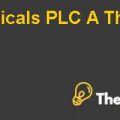Introduction:
In August 1991, the two giants of the pharmaceutical industry merged to form a new company named as Rhone-Poulenc Rorer. This merger wasundoubtedly called the biggest merger of the pharmaceutical industry at that time. The management of both companies worked together to a great degree of collaboration, skepticism and gained a lot of synergistic benefits.The major shares of Rhone-Poulenc Rorer were owned by a single shareholder Rhone-Poulenc S.A.
The sales of Rhone-Poulenc Rorer reached $2.9 billion which makes the combined company, the 13th largest company in the pharmaceutical sector. However, the aim of the management of the combined company is to bring the combined company in the top ten companies in the world, in the pharmaceutical sector. The Human Pharmaceutical business has not yet exploited the market of the United States and Japan, on the other hand, the Rorer Group was not famous in European countries. Nevertheless, Human Pharmaceutical business has a strong market in Europe and Rorer Group has huge market share in the United States and Japan. The merger of both the companies provides a good opportunity for the management to capture the market share where they have little presence.
The merger allows both companies to take advantage of the expertise of both the companies. The Human Pharmaceuticals Business has a very sophisticated I.T. system which helps the combined company to take advantage of this system and gives room for increasing the revenues and profits.Also, the supply chain of Rorer Group is more effective and efficient, which will provide the opportunity for the company to increase the supply chain management of Rhone-Poulenc as well. Furthermore, combining the operational expertise and research and development of both companies will also bring some innovation in the products of both the companies, which ultimately pushes the Rhone-PoulencRorer to stay ahead from its competitors.
Rhone Poulenc Rorer Inc. Harvard Case Solution & Analysis
The purchase consideration of this merger was different from the purchase consideration of the mergers at that time. But, this non-conventional purchase consideration is most beneficial for the shareholders of both the companies and gives maximum return on their investment.
Answer Number 1:
The transaction between Rorer group incorporation and the Human Pharmaceutical Business (HPB) which was owned by Rhone-Poulenc is one of the most complicated merger transactions in the pharmaceutical industry. The transaction was structured in such a manner that could benefit all the parties which are involved in the transaction.
In essence, this can be classified as a transaction more appropriately, rather than acquisition because both the companies want to take advantage from the acquisition. The reason for the complexity of this transaction is thatRhone-Poulenc cannot acquire with just cash consideration or cannot issue further shares due to the following constraints. The first inability is that it does not have enough cash resources to undertake such a large acquisition and also it cannot issue further debt because it has high gearing than other companies operating in the pharmaceutical sector. Further increase in debt will also increase the gearing level and result in the additional covenants being imposed on Rhone-Poulenc, which can slow down the process of growth........................
This is just a sample partical work. Please place the order on the website to get your own originally done case solution











